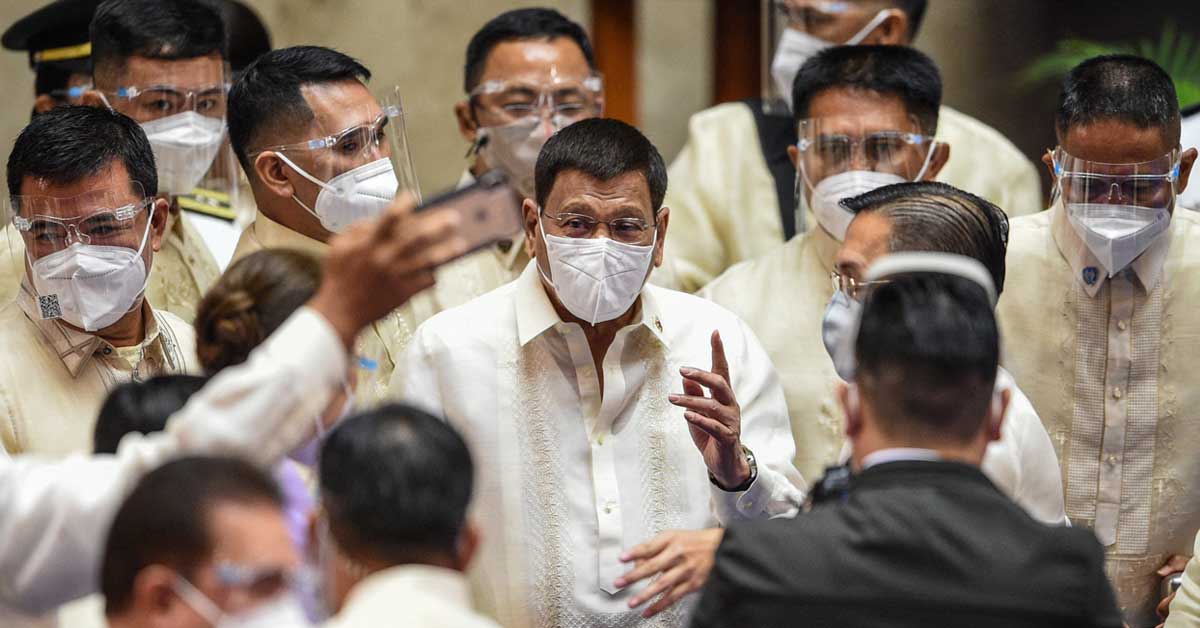In the area of foreign policy, President Rodrigo Duterte was successful in the historic return of the “Balangiga Bells” from the United States (US). Duterte also adopted an independent foreign policy of being a friend to all and enemy to none, which has benefited the country a lot both economically, security-wise, and even amid the COVID-19 pandemic.
Under the Duterte administration, “independent foreign policy” is established on fostering a broader and differentiated set of relationships solely based on Philippine national interests, designed to maximise the country’s autonomy, security, and prosperity.
Duterte made considerable change to foreign policy by re-orienting the Philippines' diplomatic relations to more friendly and constructive relations and engagement with China as opposed to a more pro-United States (US) stance; going against the antagonistic relationship towards the Communist state under the late President Benigno Aquino III’s administration.
Rapprochement Policy
The “rapprochement” policy (re-establishment of cordial and friendly relations) towards China pursued by Duterte upon ascending to the office of the presidency in 2016, is one of the legacies of his administration.
Indeed, Duterte has spent more than five years in repositioning the Philippines from a staunch pro-American stance towards a neutral one by pursuing an “independent foreign policy,” intending to find a “geopolitical nonaligned position” or a “middle ground” between the US and China, where the Philippines remains a friend of the former but at the same time deepens its friendship and mutual understanding of the latter from an economic perspective in order to maximise national interests.
Hence, the Philippines was indeed able to redefine its relationships with its most important partners like China and the US, by positioning itself to better advance its interests in an evolving, ever-volatile, and tension-driven regional order.
The rapprochement policy towards China is a pragmatic decision because if nothing had been done to this effect, the Philippines would be caught “flat-footed” by changes in the Asia-Pacific region power structure.
One has to take cognizance of the geopolitical reality that, despite the noise, posturing, and grandstanding of the US and its aggressive “Pivot to Asia” or “US Indo-Pacific Strategy” aimed at undermining China economically, politically, and militarily, while declaring that it has “national interest” in the South China Sea (SCS); it is only a matter of time before a complete shift in the global centre of power in Asia will take place.
China is ultimately at the centre of this shift in the power structure in the Asia-Pacific region and will eventually be the predominant power – if not already – in the Asia Pacific region and beyond. Thus, the Philippines needs to attain some margin of flexibility and latitude to manoeuvre around the two superpowers. This has been achieved under the Duterte presidency to a considerable extent.
Under Duterte, the Philippines has forged deeper friendly and cooperative relations with China on issues and matters where there already existed mutual understanding in areas where the two countries have no disputes or differences such as economics and trade, science and technology, cultural exchanges, and people-to-people relations; while it tries to resolve its differences and conflict of interests with China more specifically in the SCS through diplomatic and peaceful means within the ambit of ASEAN.
This foreign policy shift to some extent boosts the mutual understanding, trust, and confidence between the two nations and was re-affirmed by President Duterte in his pre-recorded weekly “Talk to the People” address on 13 December, 2021 where he said that, “the Philippines’ good relations with China remain, stressing the superpower was the “first one” to provide COVID-19 vaccines when supplies were scarce at the time.
“The West Philippine Sea (WPS) issue which is the centre spot of the differences between the Philippines and China is another matter separate from the friendship of the two countries,” Duterte added.
The first batch of donated Chinese COVID-19 vaccines arrived in the country as early as 28 February, which made possible the launch of the national vaccination program of the Philippines on 1 March, 2021. Whereas, the fifth batch of two million doses of Sinovac vaccines donated by China arrived on 14 December, 2021. To date, China has provided more than 57 million vaccine doses to the Philippines through commercial procurement and donation.
China also extended anti-pandemic assistance to Filipinos with a continuous supply of anti-pandemic materials such as medicines, testing kits, face masks, personal protective equipment (PPEs), and others goods, which helped in the COVID-19 response of the Philippines.
China also donated around 10,000 metric tons (MT) of rice to the Philippines that benefitted more than a million Filipinos during the pandemic. It has also donated around 4,000 tablets to help Filipino students across the country in their distance/blended learning programs and provided government scholarships to more than 500 teachers and students nationwide amounting to around 50 million pesos (US$998,000) in total.
China also distributed millions of food bags/packs that benefited almost one million Filipino families and provided livelihood projects benefitting many during the pandemic.
Comprehensive Strategic Cooperation
Philippines-China bilateral relations have not only improved under the Duterte administration but have been upgraded to “comprehensive strategic cooperation.” Indeed, the ties between the two countries have improved dramatically despite differences as exemplified by the eight times face-to-face meetings between President Duterte and President Xi Jinping which boosted a deepening friendship and mutual understanding between the two countries.
The two leaders are often in touch with each other through “cloud diplomacy” via phone calls and the exchanging of letters and messages.
On 27 October, 2021, President Xi held a phone conversation with President Duterte where the two leaders reached an important consensus and discussed the future cooperation between the two countries. President Xi expressed that China attaches great importance to its bilateral relations with the Philippines and supports the Philippines’ independent foreign policy of peace and cooperation.
According to President Xi, China is ready to deepen friendship and mutual trust with the Philippines, stay committed to good neighbourliness and friendship and ensure the long-term and stable development of bilateral relations along the right track.
Philippines-China relations have not only gained some new vitality under the Duterte administration but has yielded fruits and tangible benefits for the country and its people, ushering in a “Renaissance of Philippines-China Relations.”
Economics And Trade
By the same token, the Philippines has benefited also economically from the warming relationship with China, which is quite important as the country aims to bounce back from the economic devastation and recession caused by the pandemic.
To date, China remains the largest trading partner of the Philippines. It is now the country’s number one trading partner, number one import source, the number two export market, a major foreign investor, and the second-largest source of tourists for the Philippines.
In the first 10 months of 2021, the country’s exports to China were valued at around US$18 billion, with a 15 percent year-on-year increase, accounting for 29 percent of the country’s total export volume. In the first half of 2021, China’s investment in the Philippines increased by 231 percent compared to 2020.
During the first seven months (January to July) of 2021, China’s non-financial direct investment in the country reached US$110 million, with a year-on-year increase of 36 percent. For example, DITO, a flagship telecom project by China Telecom is expected to obtain a US$5 billion investment and create more than 30,000 jobs in the country.
Whereas, Panhua Group’s Integrated Steel Mill project, which is under construction, has an investment amounting to US$3.5 billion for phase 1, and is expected to double the annual steel output of the country.
China in support of the Duterte’s administration’s flagship Build Build Build (BBB) program, has donated two bridges, the Estrella-Pantaleon (E-P) Bridge which was completed in June 2021, and the Binondo-Intramuros (B-I) Bridge, which is expected to be completed this year or early 2022.
Whereas the Chico River Pump Irrigation project is expected to be completed this year or early 2022, while the Kaliwa Dam project is still under construction. Other government-to-government projects like the Samal Island-Davao City Connector Project which is in progress, costs billions of dollars.
Scientific And Technological Cooperation
The renaissance of Philippines-China relations extends to the cooperation of both countries in science and technology (S&T). For instance, after two decades of hard work between the two sides, the Philippines-Sino Center for Agricultural Technology (PhilSCAT) has become the emblem of the agricultural cooperation between the Philippines and China.
It has extended agricultural technical training to more than 15,000 Filipino professional technicians and local farmers, which benefitted more than 134,000 farmers and boosted agricultural outputs by 308,000 tons, equivalent to an increase of about three kilograms of rice for each Filipino.
Other S&T projects between the two countries include aquaculture, corn planting, sericulture development, rubber industry promotion, and research. Telecommunication companies like Huawei, Fiberhome, and ZTE are working in cooperation with Philippine universities and research institutions to jointly train Filipino talents and set up laboratories for 5G technology.
Chinese vaccine manufacturers are exploring possibilities with their Filipino colleagues with regards to vaccine research and development and clinical trials; while Alibaba, Tencent, Bytedance, and other Chinese tech companies have invested in Bit Data, cloud calculation, and the digital economy by providing technical and financial support to their partners in the Philippines.
Conclusion
The renaissance of Philippines-China bilateral relations despite existing differences is one of the legacies of the Duterte administration that has yielded tangible and concrete benefits for both countries and their peoples. This legacy of President Duterte and the gains generated for the country are worth continuing regardless who becomes the next president after the May 2022 national elections.
Filipinos must take cognizance of the fact that the country’s differences with China over the disputed waters of the SCS are just a small part of its bilateral relations with China. Thus, the Philippines should focus on positive aspects of that bilateral relations which bring tangible economic benefits to the country, while actively resolving its differences with China over the disputed waters of the SCS through peaceful means and diplomacy at all levels possible.
The Philippines, China and the rest of the claimant-states should actively seek and explore joint bilateral and multilateral cooperation on fishery management, environmental cooperation, and oil and gas joint development and exploration among others, which are important economic issues that might trigger potential conflicts if not addressed.
If given the chance, cooperation might boost mutual trust and confidence between the two countries, thus serving as a “win-win” compromise that may trigger the resolution of disputes over the SCS.
This Is Part 4 In A Series Of Articles On The Duterte Legacy
The views expressed in this article are the author’s own and do not necessarily reflect those of The ASEAN Post.

